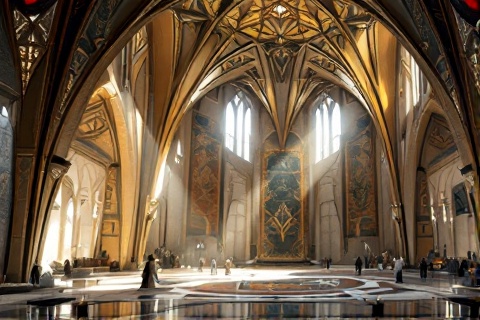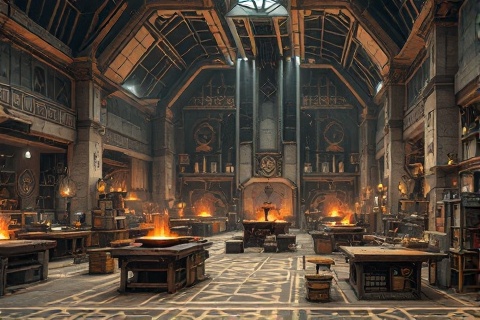
Formenos: Fortress of Exile and Secrets
Unveiling the Hidden Sanctuary of Fëanor in Tolkien's Legendarium
Location and Architecture

Formenos stood as a majestic stronghold in the northern reaches of
Valinor, nestled among the rolling hills that approached the
towering Pelóri Mountains. The fortress's location was carefully chosen for its
strategic value, offering both seclusion and natural defense against potential
threats from the north, though few could have foreseen the darkness that would
eventually find it.
The fortress-treasury served a dual purpose that reflected the complex needs of
its master, Fëanor, and his followers during their exile
from Tirion. Its primary function was to serve as a secure dwelling place for
the House of Fëanor, while simultaneously providing an impregnable vault for his
greatest works, including the legendary Silmarils.
The architectural style of Formenos showcased the highest achievements of
Noldorin craftsmanship, featuring intricate geometric patterns
that adorned its walls and columns. The fortress's windows were crafted from
specially cut crystals that captured and refracted the light of the Two Trees,
creating mesmerizing displays throughout its halls and chambers.
Every aspect of Formenos reflected Fëanor's unparalleled skill as a craftsman
and his determination to create a structure that would stand as a testament to
Noldorin achievement. The fortress combined aesthetic beauty with practical
impregnability, featuring seamlessly integrated defensive features that did not
detract from its architectural splendor.
Fortress Design and Defenses

The outer fortifications of Formenos were constructed using pale stone quarried
from the northern hills, arranged in multiple concentric layers of defense.
These walls incorporated advanced Noldorin engineering principles, with each
successive layer designed to be higher and stronger than the last, creating an
almost insurmountable barrier to any who might seek to breach them.
The fortress took full advantage of its hillside location, with sections of the
structure built directly into the natural rock formations. This integration of
natural and constructed defenses created a seamless defensive system that
maximized the tactical advantages of the terrain while minimizing potential
vulnerabilities.
Tall watch-towers rose at strategic intervals along the fortress walls,
providing guards with unobstructed views of the surrounding landscapes. These
towers were equipped with sophisticated signaling systems that could quickly
alert the entire fortress to any approach, whether friendly or hostile.
Deep within the fortress, the most secure chambers were reserved for Fëanor's
greatest treasures and works. These vaults were constructed with multiple layers
of security, incorporating both physical barriers and enchantments that made
them virtually impenetrable to all but those who knew their secrets.
Interior Layout and Halls

The main halls of Formenos displayed the finest examples of Noldorin artistry,
with walls adorned with intricate tapestries depicting the history of the Noldor
and the creation of Arda. These grand spaces featured high, vaulted ceilings
supported by columns carved with flowing patterns that seemed to capture the
very essence of Noldorin craft.
The private quarters of Fëanor, his sons, and their
most trusted followers were designed with both comfort and security in mind.
These chambers combined practical living spaces with areas for study and
contemplation, reflecting the Noldorin value of both knowledge and craft.
The workshops and forges of Formenos were unequaled in their sophistication,
equipped with tools and facilities that allowed Fëanor and his followers to
continue their pursuits of craft and invention. These spaces were designed to
accommodate the creation of works both great and small, from delicate jewelcraft
to major architectural elements.
The treasury rooms represented the pinnacle of Noldorin security design, with
multiple chambers specifically constructed to house different categories of
precious works and artifacts. The most secure of these was reserved for the
Silmarils themselves, though they would ultimately prove insufficient against
the cunning of Melkor.
Gardens and Grounds
The terraced gardens of Formenos cascaded down the hillside in carefully planned
levels, each featuring different varieties of plants and trees brought from
various parts of Valinor. These gardens served both aesthetic and practical
purposes, providing food and materials for the fortress while creating spaces of
beauty and respite.
The fortress featured several courtyards of varying sizes, designed to
accommodate different types of gatherings and ceremonies. These open spaces
served as central meeting points where the household could assemble for
announcements, celebrations, or simply to enjoy the light of the Two Trees.
An intricate network of paths and walkways connected the various sections of
Formenos, allowing for efficient movement throughout the fortress complex. These
passages were designed with both practicality and beauty in mind, featuring
elegant archways and subtle architectural details that reflected Noldorin
aesthetic sensibilities.
Natural elements were thoughtfully incorporated throughout the fortress design,
with streams and natural rock formations preserved and enhanced to complement
the constructed elements. This integration created a harmonious blend of natural
and artificial beauty that characterized the finest examples of Noldorin
architecture.
Treasury Chambers

The vaults of Formenos represented the apex of Noldorin security design,
incorporating multiple layers of physical and mechanical protections to
safeguard their precious contents. These chambers were specifically engineered
to protect various categories of artifacts, with the most secure vault reserved
for the Silmarils and Fëanor's most powerful creations.
Throughout the fortress, a network of secret passages and hidden chambers
provided additional security and escape routes if needed. These concealed spaces
were known only to Fëanor and his most trusted sons, designed with such skill
that they were virtually undetectable to those who did not know of their
existence.
The locking mechanisms employed throughout Formenos showcased the heights of
Noldorin ingenuity, featuring complex systems of gears, levers, and magical
wards. These locks were masterpieces of engineering, requiring specific
combinations of physical keys and spoken words to open, making them nearly
impossible to breach without proper authorization.
Living Quarters
The private chambers of Fëanor and his seven sons were located in the most
secure section of the fortress, each suite designed to reflect the individual
preferences and needs of its occupant. These rooms featured private studies,
sleeping chambers, and personal workspaces where they could pursue their
individual interests and crafts.
The fortress contained numerous living spaces for the extended household,
including quarters for craftsmen, scholars, and servants who had followed Fëanor
into exile. These chambers were comfortably appointed while maintaining the
practical efficiency characteristic of Noldorin design.
Common areas throughout Formenos provided spaces where the household could
gather for meals, discussions, and social activities. These halls were designed
to foster a sense of community among the exiles, featuring long tables,
comfortable seating areas, and spaces for music and storytelling.
The personal study rooms and libraries of Formenos housed an extensive
collection of knowledge brought from Tirion, including texts on crafting, lore,
and history. These spaces were carefully climate-controlled to preserve the
precious manuscripts and featured specially designed lighting systems to
facilitate reading and study.
Workshops and Forges

The crafting areas of Formenos were organized according to material and purpose,
with separate workshops dedicated to metalworking, woodcraft, textile
production, and other specialized skills. Each space was equipped with tools and
facilities specifically designed for its intended use, reflecting the Noldorin
commitment to excellence in all forms of craft.
The forge areas featured sophisticated ventilation systems that could be
precisely controlled to maintain optimal temperatures for different types of
metalwork. These systems utilized natural air currents enhanced by engineered
channels to provide clean air and remove smoke and fumes efficiently.
Extensive storage facilities were maintained throughout the crafting areas,
housing raw materials ranging from precious metals and gems to more common
materials used in daily work. These storage spaces were carefully organized and
inventoried, ensuring that materials were properly preserved and readily
available when needed.
The gem-cutting and metalworking areas were particularly well-equipped,
featuring specialized tools and workstations designed by Fëanor himself. These
spaces included precision instruments for working with the finest materials,
allowing the creation of works that approached the mastery of the Silmarils
themselves, though none would ever equal their glory.
